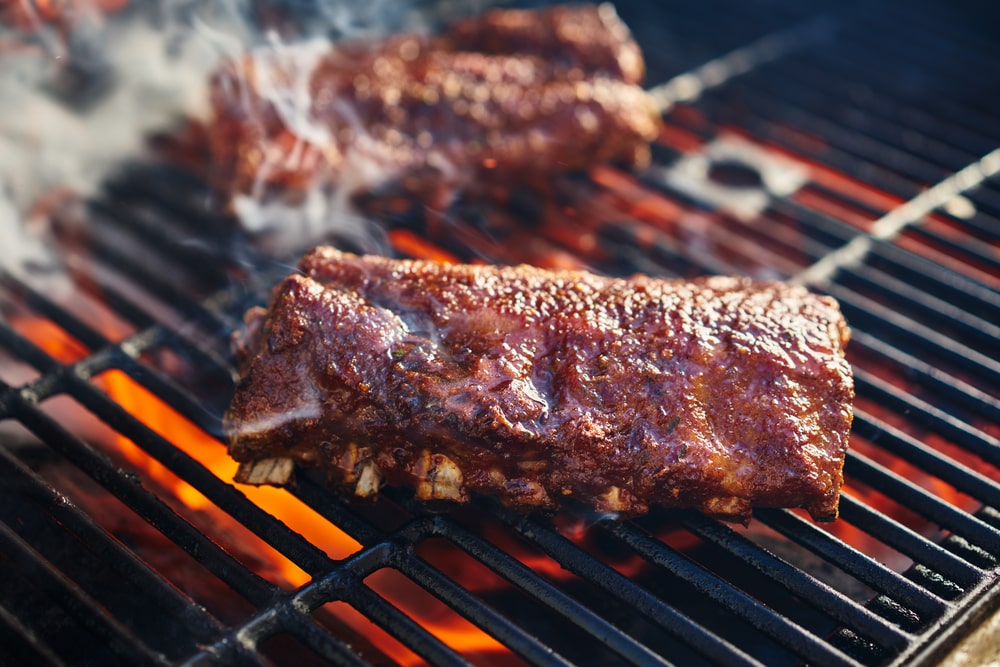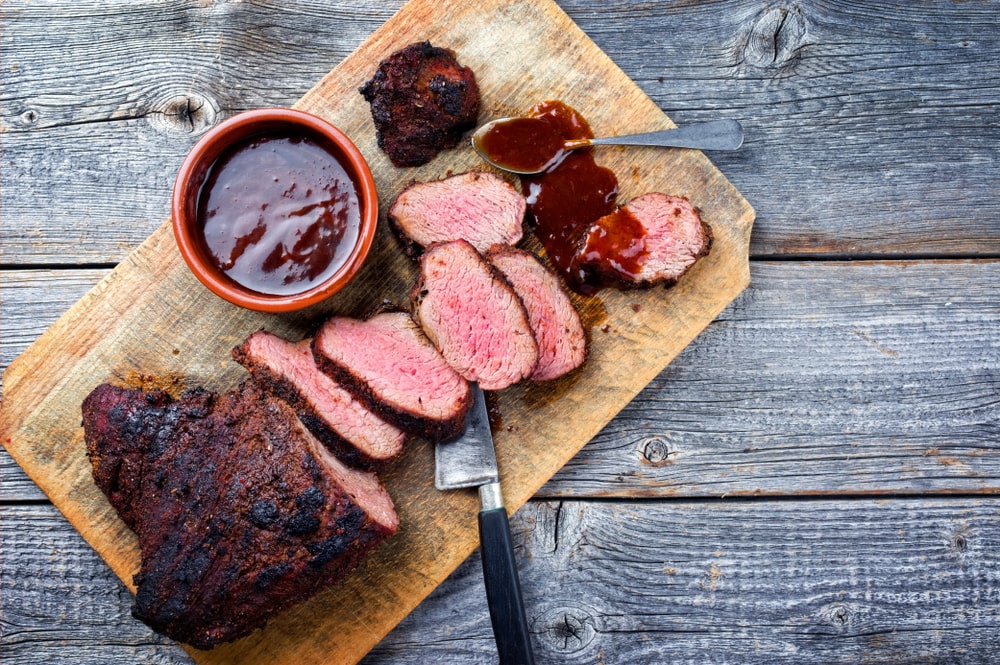The Ultimate Guide to Dry Rubbing Chicken, Ribs, Brisket, Steak, & Pork

You bust out your grill. You have the meats. Spices and seasonings? Check and double-check. “Bad day to be a brisket,” you say, steely-eyed.
The spirit of a celebrity chef possesses you. What would they do?
A dry rub. That’s what.
But you’re not a celebrity chef (sadly). You’re not up on the latest dry rub techniques. So you scour online blogs for a little dry rub refresher with some zesty tips and recipes.
Welcome, bbq blog wanderer. Your guide to dry rubbing awaits.
What Is a Dry Rub?
Dry rubs are mixtures of dry ingredients (herbs) and spice ingredients for coating and flavoring meat.
The trick is finding the right marriage of flavors. We recommend you blend sweet, savory, and spicy ingredients into your dry rub for a one-way ticket to flavor town.
For a sweet base, use brown sugar. For heat, use either cayenne or chili powder. All other ingredients are savory flavors: salt, black pepper, onion powder, garlic powder, cumin, coriander, and paprika.
Other common dry rub seasonings include jerk seasoning, sate, curry blends, and Old Bay seasoning. We recommend experimenting with different spices to find a good balance that suits your taste. Once you’ve found your special blend of herbs and spices, you’re ready to rub.
Dry Rubbing vs. Wet Rubbing
It’s the age-old question: dry rub or wet rub? And what’s the difference?
Dry rubs are mixtures of herbs and spices put on the outside of raw meat to flavor it before putting it on the grill.
Wet rubs are the same thing, except they are in an oil or other liquid base–think of them as a thick paste. Basically, a dry rub can be turned into a wet one by adding a liquid ingredient.
To decide on dry rubbing vs. wet rubbing, here are some pros and cons for each.
Dry Rubbing Pros:
- Dry rubs create a crispier crust on the outside of the meat.
- They’re quicker and easier to apply than wet rubs.
- Dry rubs work on any meat, whereas wet rubs may not.

Dry Rubbing Cons:
- Dry rubs can sometimes overpower the flavor of the meat you’re coating.
- If you don’t apply the dry rub correctly, it may not fully penetrate the meat, resulting in varying/uneven flavor.
Wet Rubbing Pros:
- Wet rubs fully penetrate the meat, so the flavor is more likely to spread out evenly.
- Liquid from the wet rub can help keep the meat moist during cooking.
- Wet rubs are usually less overpowering flavor-wise than dry rubs.
Wet Rubbing Cons:
- Wet rubs are usually more difficult to apply than dry rubs.
- Wet rubs take longer. They require more prep time than dry rubs.
- Wet rubs are usually a messier process than dry rubs.
How to Apply Dry Rub
Once your rub is mixed, spread it in a rimmed baking sheet or large bowl. Add your meat and generously rub and massage the mix into the meat.
For certain meats like chicken breast, brisket, or pork, consider rubbing your dry rub in and then refrigerating your meat overnight. This will allow the spices to sink into the meat. While not an essential step, refrigerating your meat can give your dry rub a more flavorful kick.

Dry Rub Recipes to Try
Now that you’ve got the dry rubbing basics, it’s time to get grillin’. Try out these recipes to see how much spice knowledge rubbed off on you.
Dry Rub Chicken Wings
Orange Hoisin Spiced Chicken Wings courtesy of www.eatchicken.com.
Dry rub ingredients:
- 2 tbsp. five spice powder
- 2 tsp. ground ginger
- 2 tsp. chili powder
- 2 tsp. kosher salt
- ½ tsp. cayenne pepper
Apricot Glazed Grilled Chicken Wings courtesy of www.eatchicken.com.
Dry rub ingredients:
- 1 tsp. kosher salt
- ½ tsp. red pepper flakes
- ½ tsp. cumin
Dry Rub for Ribs
Backyard Barbecue Spareribs courtesy of National Pork Board.
Dry rub ingredients:
- 2 tsp. paprika
- 2 tsp. chili powder
- 1 tsp pepper
Brisket Dry Rub
Texas BBQ Beer Brisket courtesy of The Beef Checkoff.
Dry rub ingredients:
- 2 tbsp. chili powder
- 1 tbsp. packed brown sugar
- 1 ½ tsp. garlic powder
Fall-Apart Beer Brisket courtesy of The Beef Checkoff.
Dry rub ingredients:
- ½ tsp. salt
- 1 ½ tsp. dried oregano leaves
- 1 tsp. dried thyme leaves
Steak Dry Rub
Dry BBQ Rub courtesy of The Beef Checkoff.
Dry rub ingredients:
- 2 tbsp. chili powder
- 2 tbsp. packed brown sugar
- 1 tbsp. ground cumin
- 2 tsp. minced garlic
- 2 tsp. cider vinegar
- 1 tsp. worcestershire sauce
- ¼ tsp. ground red pepper
Chili-Crusted Tri-Tip Roast courtesy of The Beef Checkoff.
Dry rub ingredients:
- 1 tbsp. chili powder
- 2 tsp. ground cumin
- 1 tsp. onion powder
- ½ tsp. garlic powder
Pork Dry Rub
Roasted Pork Tenderloin with Asian Dry Rub courtesy of National Pork Board.
Dry rub ingredients:
- 1 tbsp. light brown sugar, packed
- 1 tsp. ground ginger
- ¼ tsp. cinnamon
- ¼ tsp. salt
- ¼ tsp. black pepper
- ⅛ tsp. ground cloves
- ⅛ tsp. ground cayenne pepper
Dry Rubbed Porterhouse Pork Chops with Steakhouse Butter courtesy of National Pork Board.
Dry rub ingredients:
- 2 tsp. kosher salt
- 2 tsp. raw or turbinado sugar
- 1 tsp. chili powder
- ½ tsp. ground coriander
- ½ tsp. granulated garlic
- ½ tsp. black pepper
- ½ tsp. granulated onion
Ready to prepare your next dry rub? Get your fresh ingredients at Stauffers of Kissel Hill. Or save time and order your groceries online for pickup or delivery.
